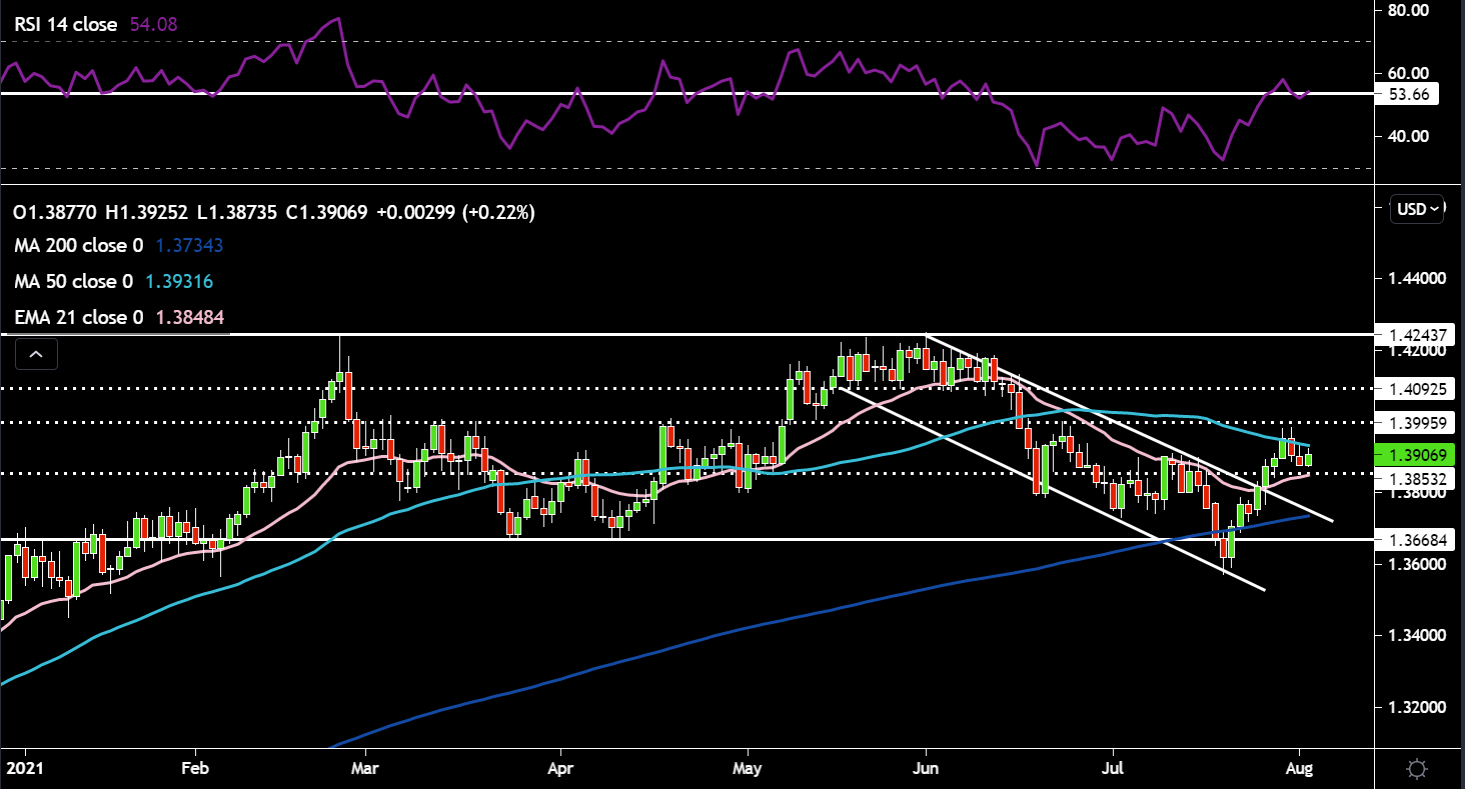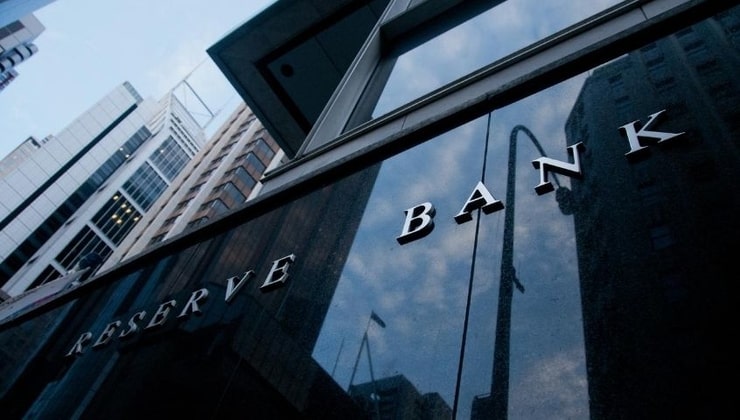- Français
- English
- Español
- Italiano
Analyse
Updated Growth Projections, Hawks getting louder and the Exit Sequencing Review - don't miss this BoE Meeting
.jpg)
The Old Lady of Threadneedle Street graces us with her presence this Thursday and the market will be trying to decipher her mood – hawkish or dovish. This meeting is certainly not going to be short on content, we’ve got updated economic projections, decisions regarding feasibility of negative rates and potentially more on the exit sequence on the road to policy normalization. I’ll flesh out more detail on each component part below and also highlight where hawkish risks could arise.
First up, policy action regarding interest rates and QE will remain unchanged. The vote on QE will likely not be unanimous, but certainly not enough to bring the BoE’s asset purchase programme to a halt. Looking at 10-year Gilts and the 2s10s curve, an early end to QE is not being discounted by the market. In terms of votes, my money is on Saunders being the dissenting vote with an outside chance of him bringing Ramsden over to that view too. The majority of MPC members lean dovish and will prefer to err on the side of caution. The reasons for taking a more cautious approach stem from 1) Inflation pressures being viewed as transitory 2) Medium-term market based inflation expectations remaining anchored 3) Delta variant uncertainty (improving however, with cases and hospitalisations declining) 4) Furlough scheme expiry. The MPC needs to assess where unemployment peaks at as well as the speed at which employment recovers from the peak – they can only do this once the distortionary effects of the furlough scheme have been removed. I think informational content to be gleaned from the QE vote relates more to the timeline for rate hikes. With more dissents potentially bringing forward lift-off. A 6-2 vote could be seen as hawkish. Equally, if we saw no dissenting votes and the vote came in 8-0 that would be a dovish surprise. Could this be an opportunity for traders?
Economic Projections and Negative Rates:
Beginning with the growth outlook my expectations are for a slight downgrade to Q3 and upgrade to Q4, leaving the economy on track to reach pre-covid levels by Q4 of this year. There are a couple factors responsible for this slowdown in growth momentum in the near-term – 1) Freedom day pushed back and rising delta cases sapping consumer optimism 2) Lower mobility 3) Constraints on supply 4) “Pingdemic”, 600k people told to self-isolate (how many actually isolated is another thing). The reopening was always going to be a bit of a bumpy ride. A lower scarring estimate would reduce hysteresis effects and potentially give a small boost to medium-term growth projections.
Inflation is likely to receive a chunky upgrade of around 100 bps (maybe even more) on the current 2.5% May forecast for Q4. Supply chain disruptions, higher crude prices and a low base effect should see this play out. This will once again be described as transitory with the view that a reversion will occur bringing inflation back to target, around 2% over the medium-term. As a nod to the inflationistas, there will probably be a line about how the MPC will remain vigilant towards upside surprises and that risks are more balanced etc. I’ll be particularly looking for where the BoE pins their inflation forecast towards the end of their forecast horizon, as a signal to money markets on whether their pricing of the BoE’s rate path outlook is too aggressive.
Lastly, on the employment side of the equation, easily one of the bank’s most important data points, it’s mixed. Labour demand is solid with job openings hitting a record in June, however, there still remains quite a lot of slack as seen by the number of people still on furlough – circa 5% of the labour force. If anything we’re most likely to see a minor upgrade to May’s projections of a 5.4% peak in the unemployment rate, but still above 5% for now.
On negative rates, we will most likely be told that they are feasible and are now part of the BoE’s arsenal of policy tools. I’d like to hear some more detail on where that lower bound would move to i.e. how negative as well as guidance on the type of circumstances that would necessitate its use.
QT/Unwinding of Balance Sheet:
There’s no guarantees we’ll get any details on the BoE’s sequence for tightening at this meeting, however, policymakers have informed they are reviewing as we speak and pressure from the House of Lords could see August as the meeting for when this strategy is communicated to markets. Currently, quantitative tightening would be triggered when the bank rate hits 1.5%, most in the market expect this threshold to be reduced to 1%. This reflects two things – additional easing capacity as a result of negative rates and Governor Bailey’s desire to create room on the balance sheet for additional QE in the event of another crisis. A hawkish surprise for the market would be a lower threshold, say 0.5-0.75% or embarking on QT before hiking rates. This should see a steepening of the yield curve which could feed through to a stronger pound. Given where yields are at the back end of the curve, I can’t see any fears over an early unwind of the balance sheet, which could be a blind spot for the market. Going the QT route before hiking rates seems the most unlikely option, as policymakers have quite clearly stated that interest rates are the preferred marginal policy tool. Additionally, the BoE unlike the Fed have never engaged in QT, so there is some uncertainty around how the market would react.
Potential Timeline for Rate Lift-off:
I think a hike in H1 2022 is a bit too punchy for the BoE with H2 2022 being a far more likely time period to see any interest rate increases. Looking at the current Overnight Index Swap (OIS) curve, the market is pricing in a 15 bps hike by June 2022 and 30 bps in total over 2022. This diverges from economists’ expectations who in a recent Bloomberg survey don’t see the MPC hiking until Q3 2023. If the BoE communicates a more cautious outlook, then we could see hike bets by June 2022 pushed back – putting some pressure on sterling. Another interesting point to note is the shape of the curve in the chart below. The curve is steep at the front then flattens out over the back end, indicating an early hike then lethargic movement on further rate hikes.

Source: Bank of England Website
GBPUSD:
In my opinion this is one of the harder pairs to call directionally. Given the Fed and BoE seem to be moving at a similar pace in terms of policy normalisation, there is a sort of a stale mate in terms of divergence. This Friday’s NFP number will be closely scrutinized by the market as Jerome Powell really emphasized at the last meeting how important a jobs recovery is in determining significant progress, which in turn determines the tapering timeline. Expectations are at 900k, so a print North of 1 mln should see the market fired up and calls for a September taper ramped up. US 10-year yields and the dollar should push higher on this outcome.

Price has bounced off its 200-day SMA, range support and weekly lows around 1.36. The 50-day SMA has acted as a bit of a headwind for Cable with price paring back as it hit the widely used moving average as well as horizontal resistance of 1.40. The candles have bullishly broken out of the mini descending channel which formed adding fuel to the bulls’ fire. The RSI is fluctuating around the key 53 level which was working to cap gains previously. There is plenty room for Cable to run before it can be considered overbought. We may be in the early stages of an inverted Head and Shoulders pattern developing (typically bullish). Targets wise, on the upside the first level to be negotiated will be 1.40 then 1.41 resistance – from there the range resistance at 1.426 could be eyed by traders. On the downside 1.385 near the 21-day EMA would be a good area of interest and below that the 200-day SMA.
EURGBP:
Price movement would seem to have an asymmetric skew for this currency as if we get a status quo meeting the BoE will still be classified as more hawkish than the very dovish ECB, but if we see hawkish undertones on Thursday then we could see a large pip move lower in the cross. Northern Ireland Brexit related issues have dampened down for now, with the EU choosing to not press ahead with legal action.

Price is pushing up against the upper trend line of the descending channel and the 21-day EMA, with the 50-day SMA and range support not that much further above. So there is lots of resistance to contend with where price is currently. The 50-day SMA has been acting as a form of dynamic resistance on price rallies. The RSI is also trapped in a range between 41 and 52. It looks like a bit of a double bottom formed around the 0.85 level which would be the target on the downside. On the upside 0.857 (50-day SMA and horizontal range support) would be a good level to monitor with 0.86 the next target for EURGBP bulls to keep an eye on.
GBPAUD:
The Aussie dollar saw strength after the RBA caught the market off guard by not reversing its taper plans due in September. Despite a growth contraction, the RBA is keeping guidance on asset purchases unchanged. However, Australia remains vulnerable to Covid given its low rate of the population vaccinated – this could help keep GBPAUD bid. The BoE is more hawkish than the RBA and we’re likely to see more hikes by the BoE over the medium-term as the RBA doesn’t see any lift-off until 2024. Lastly, the differential between the Aussie and UK 5-year yield has ticked up slightly after the RBA’s announcement, helping to push GBPAUD slightly lower. I still think this yield differential will move lower over time in favour of GBPAUD.
Price got down to as low as 1.875, but has now retraced most of this move as buyers stepped in and is only ever so slightly lower now. The RSI has moved out of overbought territory is pointing lower. There is some solid support lower offered by the 21-day EMA and horizontal support around 1.868. The golden cross which occurred in mid-May has kept the trend up allowing traders to implement a buy the dips approach within the ascending channel. In terms of price targets, on the upside the previous high around 1.90 would be a good initial level, while further moves around 1.907/8 would be prudent to monitor. On pullbacks, look to the 1.867/8 level which is around the 21-day EMA and horizontal support, beyond that 1.855 support and the lower trend line would peak my interest.
Ready to trade one of the opportunities above? Start trading FX CFDs now.
Related articles
Ready to trade?
It's quick and easy to get started. Apply in minutes with our simple application process.
Le matériel fourni ici n'a pas été préparé conformément aux exigences légales visant à promouvoir l'indépendance de la recherche en investissement et est donc considéré comme une communication marketing. Bien qu'il ne soit pas soumis à une interdiction de traiter avant la diffusion de la recherche en investissement, nous ne chercherons pas à tirer parti de cela avant de le fournir à nos clients. Pepperstone ne garantit pas que le matériel fourni ici est exact, actuel ou complet, et ne doit donc pas être utilisé comme tel. Les informations, qu'elles proviennent d'un tiers ou non, ne doivent pas être considérées comme une recommandation; ou une offre d'achat ou de vente; ou la sollicitation d'une offre d'achat ou de vente de toute sécurité, produit financier ou instrument; ou de participer à une stratégie de trading particulière. Cela ne tient pas compte de la situation financière des lecteurs ou de leurs objectifs d'investissement. Nous conseillons à tous les lecteurs de ce contenu de demander leur propre conseil. Sans l'approbation de Pepperstone, la reproduction ou la redistribution de ces informations n'est pas autorisée.

